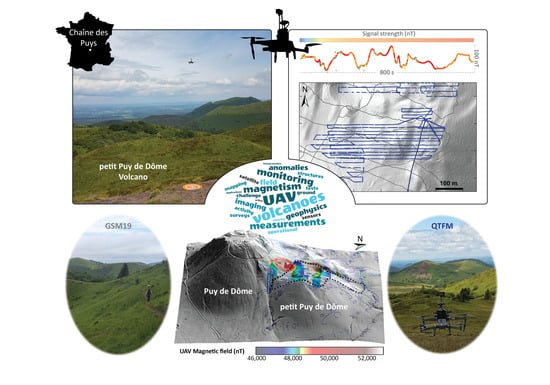Validation of a New UAV Magnetic Prospecting Tool for Volcano Monitoring and Geohazard Assessment
Abstract
1. Introduction
2. Geological Background and Choice of Field Sites
3. Datasets: Ground versus UAV Magnetometer
3.1. UAV Magnetic Measurements
3.2. Ground Magnetic Measurements
4. Results of the Magnetic Surveys and Tests
4.1. QTFM Resolution and Sensitivity (Laschamps Site)
4.2. Mapping Comparison (Petit Puy de Dôme Site)
5. Discussion and Conclusions for Potential Applications
- UAV carrier has a small but constant electromagnetic effect on the measurements.
- Environmental effects, such as wind, does not seem to clearly affect the measurements. Gusts of wind (which generate variations in the rotor speed) can create noise and high amplitudes, but they are not critical in terms of the data homogeneity. According to the tests carried out, it mainly affects the quality index, as shown by spikes on the recording.
Author Contributions
Funding
Data Availability Statement
Acknowledgments
Conflicts of Interest
References
- Antoine, R.; Lissak, C.; Lopez, T.; Tangy, M.; Gailler, L.; Labazuy, P.; Fauchard, C. Geoscientists in the Sky: Unmanned Aerial Vehicles for Geohazards Response. Surv. Geophys. 2020, 41, 1285–1321. [Google Scholar] [CrossRef]
- James, M.R.; Carr, B.B.; Arcy, F.D.; Diefenbach, A.K.; Dietterich, H.R.; Fornaciai, A.; Lev, E.; Liu, E.J.; Pieri, D.C.; Rodgers, M.; et al. Volcanological Applications of Unoccupied Aircraft Systems (UAS): Developments, Strategies, and Future Challenges. Volcanica 2020, 3, 67114. [Google Scholar] [CrossRef]
- Walter, T.R.; Jousset, P.; Allahbakhshi, M.; Witt, T.; Gudmundsson, M.T.; Hersir, P. Underwater and Drone Based Photogrammetry Reveals Structural Control at Geysir Geothermal Fi Eld in Iceland. J. Volcanol. Geotherm. Res. 2018, 391, 106282. [Google Scholar] [CrossRef]
- Gailler, L.-S.; Lénat, J.-F. Internal Architecture of La Réunion (Indian Ocean) Inferred from Geophysical Data. J. Volcanol. Geotherm. Res. 2012, 221–222, 83–98. [Google Scholar] [CrossRef]
- Gailler, L.; Kauahikaua, J. Monitoring the Cooling of the 1959 Kīlauea Iki Lava Lake Using Surface Magnetic Measurements. Bull. Volcanol. 2017, 79, 1–7. [Google Scholar] [CrossRef]
- Catalán, M.; Martos, Y.M.; Galindo-Zaldívar, J.; Funaki, M. Monitoring the Evolution of Deception Island Volcano from Magnetic Anomaly Data (South Shetland Islands, Antarctica). Glob. Planet. Change 2014, 123, 199–212. [Google Scholar] [CrossRef]
- Bonhommet, N.; Babkine, J. Sur La Présence d’aimantations Inversées Dans La Chaîne Des Puys. Comptes Rendus Hebd. des Séances l’Académies Sci. Série B 1967, 92, 264. [Google Scholar]
- Boivin, P.; Besson, J.-C.; Briot, D.; Camus, G.; de Goër de Herve, A.; Gourgaud, A.; Labazuy, P.; Langlois, E.; de Larouzière, F.-D.; Livet, M.; et al. Volcanologie de La Chaîne Des Puys, 5th ed.; Parc Naturel Régional des Volcans d’Auvergne: Rochefort-Montagne, France, 2009; p. 200. [Google Scholar]
- Plenier, G.; Valet, J.-P.; Guérin, G.; Lefèvre, J.-C.; LeGoff, M.; Carter-Stiglitz, B. Origin and Age of the Directions Recorded during the Laschamp Event in the Chaîne Des Puys (France). Earth Planet. Sci. Lett. 2007, 259, 414–431. [Google Scholar] [CrossRef]
- Guérin, G. La Thermoluminescence des Plagioclases: Méthode de Datation Du Volcanisme: Applications Au Domaine Volcanique Français: Chaîne Des Puys, Mont Dore et Cézallier, Bas Vivarais; Université Pierre et Marie Curie-Paris VI: Paris, France, 1983. [Google Scholar]
- de Vries, B.v.W.; Márquez, A.; Herrera, R.; Bruña, J.L.G.; Llanes, P.; Delcamp, A. Craters of Elevation Revisited: Forced-Folds, Bulging and Uplift of Volcanoes. Bull. Volcanol. 2014, 76, 875. [Google Scholar] [CrossRef]
- Portal, A.; Gailler, L.-S.; Labazuy, P.; Lénat, J.-F. Geophysical Imaging of the Inner Structure of a Lava Dome and Its Environment through Gravimetry and Magnetism. J. Volcanol. Geotherm. Res. 2016, 320, 88–99. [Google Scholar] [CrossRef]
- Boivin, P.; Besson, J.C.; Briot, D.; Deniel, C.; Gourgaud, A.; Labazuy, P.; Langlois, E.; de Larouzière, F.D.; Livet, M.; Merciecca, C.; et al. Volcanologie de La Chaîne des Puys Massif Central Français, Bilingue. Carte 1/25000, 6th ed.; Parc Naturel Régional des Volcans d’Auvergne: Rochefort-Montagne, France, 2017; p. 200. [Google Scholar]
- Gavazzi, B.; Bertrand, L.; Munschy, M.; de Lépinay, J.M.; Diraison, M.; Géraud, Y. On the Use of Aeromagnetism for Geological Interpretation: 1 Comparison of Scalar and Vector Magnetometers for Aeromagnetic Surveys and an Equivalent Source Interpolator for Combining, Gridding, and Transforming Fixed Altitude and Draping Data Sets Journal of Geophysical Research. Solid Earth 2020, 125, e2019JB018870. [Google Scholar] [CrossRef]
- Munschy, M.; Boulanger, D.; Ulrich, P.; Bouiflane, M. Magnetic Mapping for the Detection and Characterization of UXO: Use of Multi-Sensor Fluxgate 3-Axis Magnetometers and Methods of Interpretation. J. Appl. Geophys. 2007, 61, 168–183. [Google Scholar] [CrossRef]
- Olsen, N.; Tøffner-Clausen, L.; Sabaka, T.J.; Brauer, P.; Merayo, J.M.G.; Jørgensen, J.L.; Léger, J.M.; Nielsen, O.V.; Primdahl, F.; Risbo, T. Calibration of the Ørsted Vector Magnetometer Calibration of the Ørsted Vector Magnetometer. Earth Planets Space 2003, 55, 11–18. [Google Scholar] [CrossRef]
- Miallier, D.; Pilleyre, T.; Boivin, P.; Labazuy, P.; Gailler, L.-S.; Rico, J. Grand Sarcoui Volcano (Chaîne Des Puys, Massif Central, France), a Case Study for Monogenetic Trachytic Lava Domes. J. Volcanol. Geotherm. Res. 2017, 345, 125–141. [Google Scholar] [CrossRef]
- Jonhson, A.C.; Sarris, A.; Amza-Prein, M.E. A New Interactive FFT-Based Grid Suturing Technique Applied to Ground GeoPhysical Surveys in Greece. In Proceedings of the Second Balkan Geophysical Congress and Exhibition, Istanbul, Turkey, 5–9 July 1999; p. 3. [Google Scholar]
- Zurek, J.; Williams-Jones, G. The shallow structure of Kīlauea caldera from high-resolution Bouguer gravity and total magnetic anomaly mapping: Insights into progressive magma reservoir growth. JGR 2013, 118, 3742–3752. [Google Scholar] [CrossRef]
- Ade-Hall, J.M.; Palmer, H.C.; Hubbard, T.P. The Magnetic and Opaque Petrological Response of Basalts to Regional Hydrothermal Alteration. Geophys J R Astron Soc 1971, 24, 137–174. [Google Scholar] [CrossRef]
- Hunt, C.P.; Moskowitz, B.M.; Banerjee, S.K. Magnetic Properties of Rocks and Minerals. In Rock Physics & Phase Relations: A Handbook of Physical Constants. AGU Reference Shelf 3; Ahrens, T.J., Ed.; Wiley: Hoboken, NJ, USA, 1995. [Google Scholar]
- Bouligand, C.; Glen, J.M.G.; Blakely, R.J. Distribution of Buried Hydrothermal Alteration Deduced from High-Resolution Magnetic Surveys in Yellowstone National Park. J. Geophys. Res. Solid Earth 2014, 119, 2595–2630. [Google Scholar] [CrossRef]
- Neal, C.A.; Brantley, S.R.; Antolik, L.; Babb, J.L.; Burgess, M.; Calles, K.; Cappos, M.; Chang, J.C.; Conway, S.; Desmither, L.; et al. The 2018 Rift Eruption and Summit Collapse of K ī Lauea Volcano. Science 2019, 363, 367–374. [Google Scholar] [CrossRef] [PubMed]

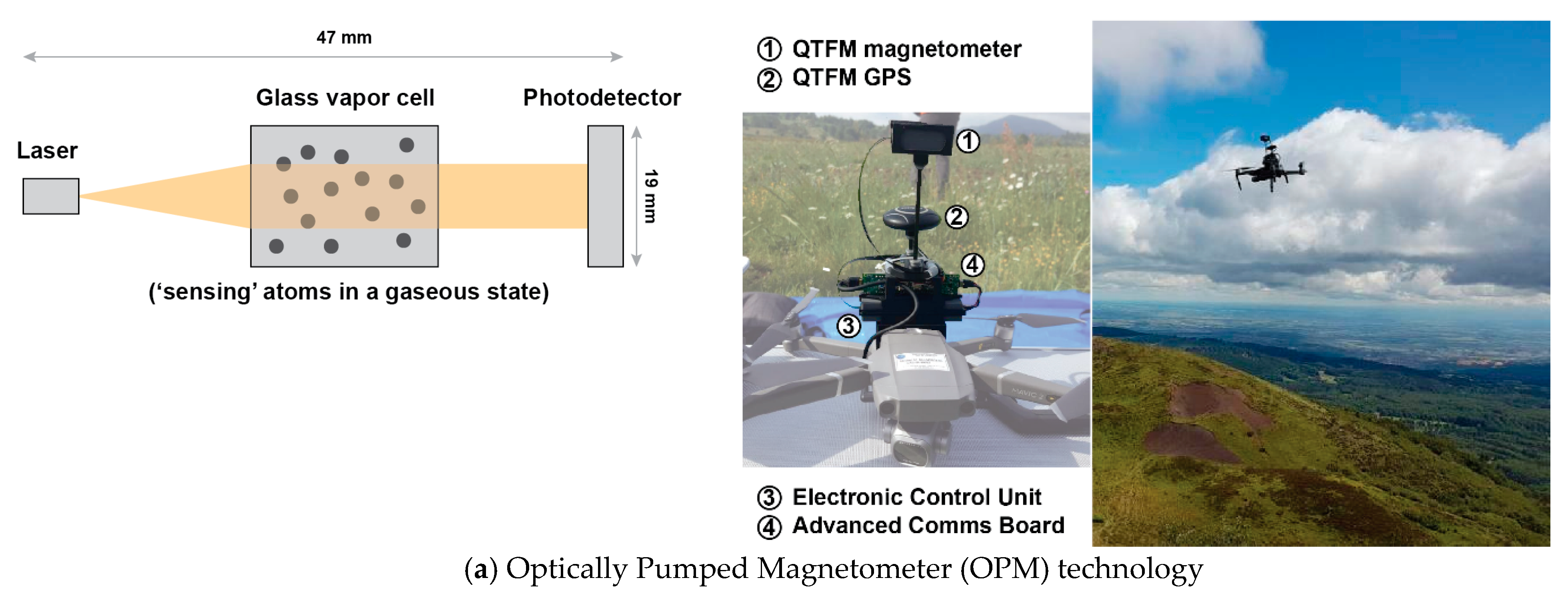
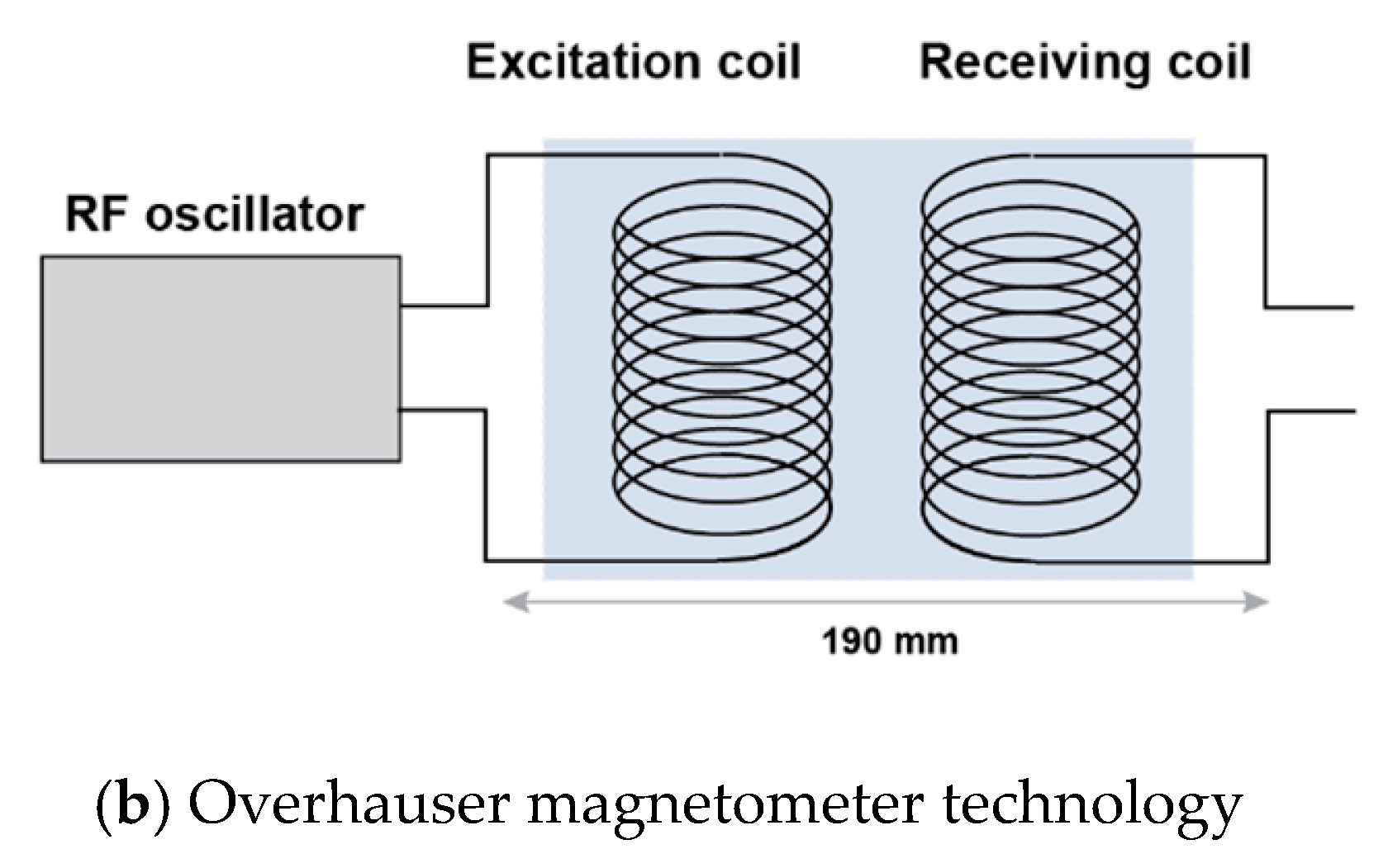

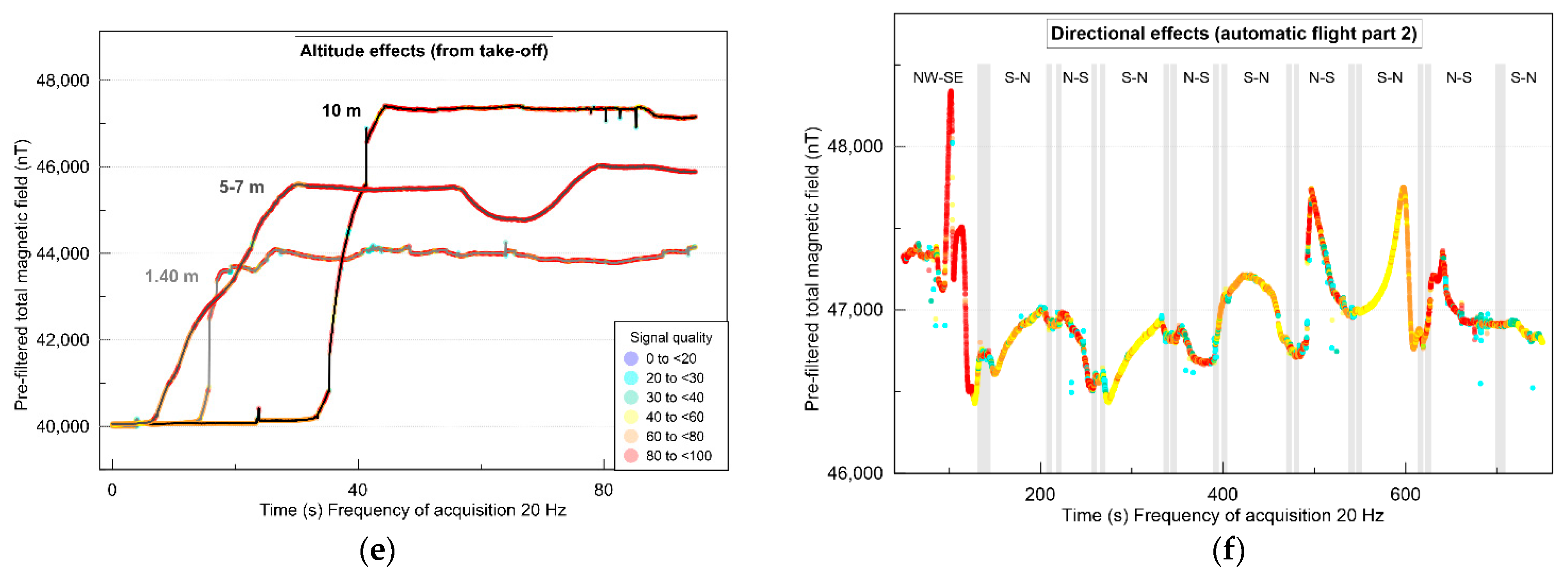
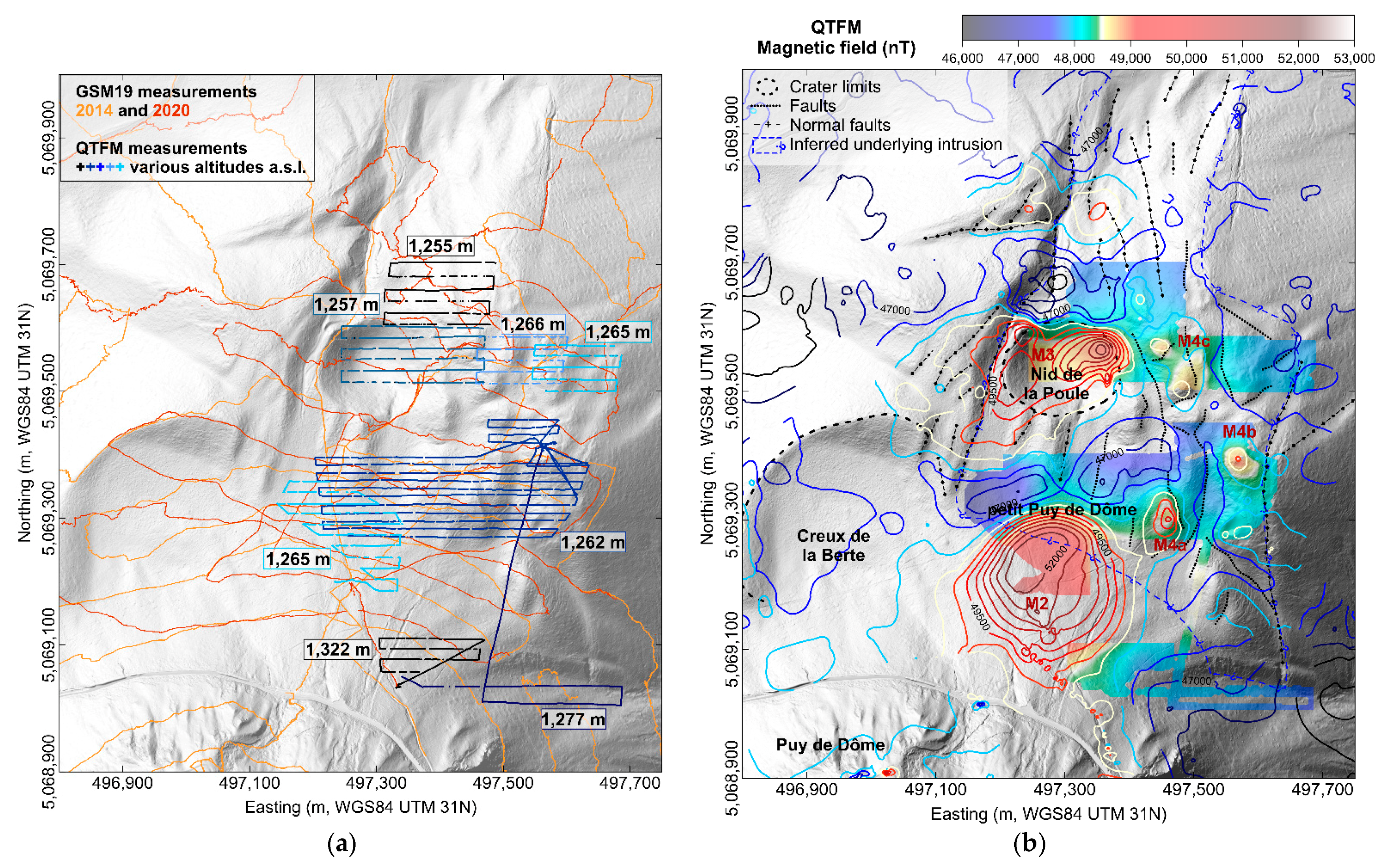
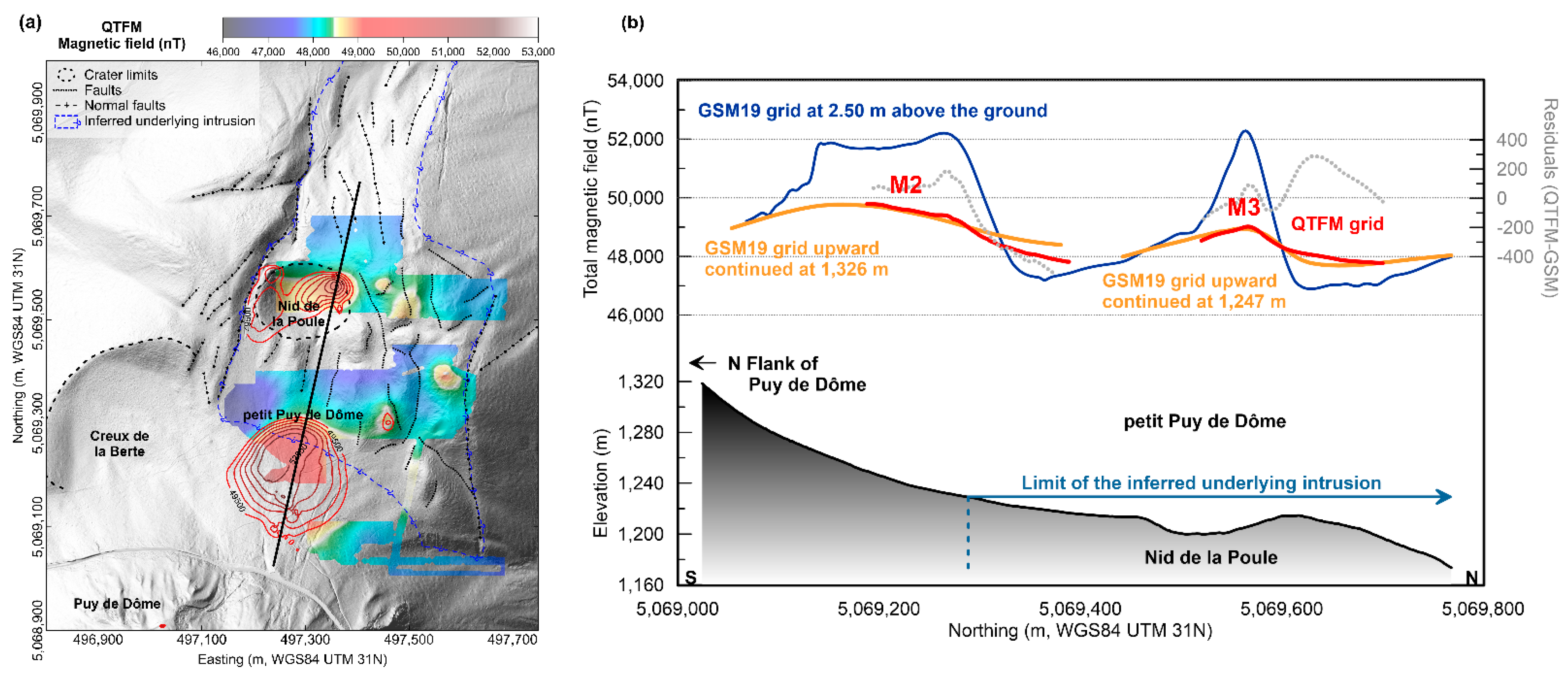
| Flight | Altitude | Items | Min nT | Max nT | Mean nT | STD |
|---|---|---|---|---|---|---|
| Manual | 5–7 m | 15 | −351.25 | 433.53 | 5.2 | 255.5 |
| Automatic part 1 | 10 m | 11 | −11.66 | 30.36 | 7.7 | 12 |
| Automatic part 2 | 10 m | 7 | −148.33 | 175.5 | 31.3 | 111.1 |
| Automatic parts 1 & 2 | 10 m | 8 | −92.23 | 59 | 0.52 | 51.9 |
Publisher’s Note: MDPI stays neutral with regard to jurisdictional claims in published maps and institutional affiliations. |
© 2021 by the authors. Licensee MDPI, Basel, Switzerland. This article is an open access article distributed under the terms and conditions of the Creative Commons Attribution (CC BY) license (http://creativecommons.org/licenses/by/4.0/).
Share and Cite
Gailler, L.; Labazuy, P.; Régis, E.; Bontemps, M.; Souriot, T.; Bacques, G.; Carton, B. Validation of a New UAV Magnetic Prospecting Tool for Volcano Monitoring and Geohazard Assessment. Remote Sens. 2021, 13, 894. https://doi.org/10.3390/rs13050894
Gailler L, Labazuy P, Régis E, Bontemps M, Souriot T, Bacques G, Carton B. Validation of a New UAV Magnetic Prospecting Tool for Volcano Monitoring and Geohazard Assessment. Remote Sensing. 2021; 13(5):894. https://doi.org/10.3390/rs13050894
Chicago/Turabian StyleGailler, Lydie, Philippe Labazuy, Edouard Régis, Martial Bontemps, Thierry Souriot, Guillaume Bacques, and Bruno Carton. 2021. "Validation of a New UAV Magnetic Prospecting Tool for Volcano Monitoring and Geohazard Assessment" Remote Sensing 13, no. 5: 894. https://doi.org/10.3390/rs13050894
APA StyleGailler, L., Labazuy, P., Régis, E., Bontemps, M., Souriot, T., Bacques, G., & Carton, B. (2021). Validation of a New UAV Magnetic Prospecting Tool for Volcano Monitoring and Geohazard Assessment. Remote Sensing, 13(5), 894. https://doi.org/10.3390/rs13050894





